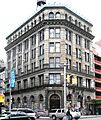Germania Bank Building (New York City) facts for kids
The Germania Bank Building is a really old and cool building in New York City. You can find it at 190 Bowery street, right where it meets Spring Street in an area called Nolita, Manhattan. It was built a long time ago, in 1898–1899, for the Germania Bank. A famous architect named Robert Maynicke designed it in a fancy style called Renaissance Revival or Beaux Arts. Today, it's a private home, but it's also a special landmark in New York City because of its history and beautiful design. It became a New York City designated landmark on March 29, 2005.
What the Building Looks Like
The Germania Bank Building has six floors. It's made of strong brick with steel beams inside, and it has a concrete basement. The outside walls that face Bowery and Spring Street are covered with beautiful granite stone.
The bottom part of the building looks very solid, with big, deep-set windows that have rounded arches over them. Above this, the stone walls have stripes. There are three sets of paired windows facing Bowery and six sets facing Spring Street.
The third, fourth, and fifth floors have parts that stick out between the windows. The windows on the sixth floor have round arches. There's a decorative ledge, called a cornice, above the first floor. A bigger, more detailed cornice is above the fifth floor.
At the very top, there's a copper border that looks like a classic roof edge. It has cool designs like flower shapes, rosettes, and waves. This part would have been easy to see from the old elevated trains that used to run by.
The main entrance is on the angled corner of the building. It has stone steps and a small porch with columns. There's also another entrance on the Bowery side. Both entrances have fancy wrought-iron gates and columns. The main doorway also has decorated pillars on the sides and an arched window above it.
The other two sides of the building are made of brick. The windows on the north side have steel shutters for protection. Many of the original windows were still there in 2005. Inside, the main banking hall was changed in 1922. More stairs were added in 1924. Later, the building was changed to be a home, and a basketball court was even built in the old banking hall!
History of the Building
In the mid-1800s, many German immigrants came to New York City. They created a neighborhood called Kleindeutschland, or Little Germany. This became a very important center for German-Americans in the United States. Its main business area was on the Bowery street.
The Germania Bank of the City of New York was started by local business people in 1869. Its first office was at 185 Bowery. The bank's first president was Christian Schwarzwaelder, who owned a furniture store. The vice-president, Joseph Kuntz, owned a brewery.
In 1878, the bank moved to a building they bought at 215 Bowery. In the early 1890s, they grew and took over the building next door at 217 Bowery. To keep growing, the bank bought three more lots at the corner of Bowery and Spring Street in December 1896.
Plans for a new, strong, fireproof building were made on January 3, 1898. The building was designed by Robert Maynicke, who was born in Germany. This building is considered one of his most important works. A company called Marc Eidlitz, whose family was also German-American, built it. It cost about $200,000, which was a lot of money back then!
Construction started on February 4, 1898, and was finished on January 21, 1899. The bank opened for people to look at on December 28, 1898, and started doing business on January 3, 1899.
Edward C. Schaefer was the president of the Germania Bank at that time. The building originally had a public banking hall on the first floor. There were also super-safe vaults in the basement and offices for the president and the Board of Directors. In 1900, the bank even made a brochure to tell people how secure their vaults were!
The Germania Bank changed its name to the Commonwealth Bank in early 1918. This probably happened because people felt strongly against Germany during World War I. In the mid-1920s, the Bowery area had many banks, and Commonwealth Bank was one of five in that part of the street.
Starting in 1923, Commonwealth Bank opened branches in other parts of Manhattan, and also in the Bronx and Brooklyn. Later, in 1927, a bigger bank called Manufacturers Trust Company bought Commonwealth Bank. This company later became Manufacturers Hanover Trust Company in 1961.
Manufacturers Hanover used 190 Bowery as a bank branch until the mid-1960s. In 1966, they sold the building to Jay Maisel, a photographer. Mr. Maisel lived there, had his photography studio, and even got married there in 1989. For a few years, he rented parts of the building to other artists like Adolph Gottlieb and Roy Lichtenstein.
The building was often called "The Bank" by local people and many thought it was empty. It cost $300,000 each year to keep up, including heating and taxes. In August 2014, it was quietly put up for sale. On February 5, 2015, it was sold to Aby Rosen. A 2019 documentary film called Jay Myself shows Mr. Maisel moving out of the building after living there for 49 years.
Images for kids
See also
 In Spanish: Germania Bank Building (Nueva York) para niños
In Spanish: Germania Bank Building (Nueva York) para niños



